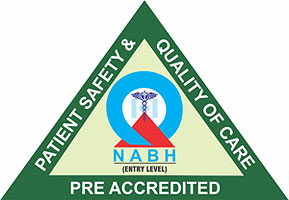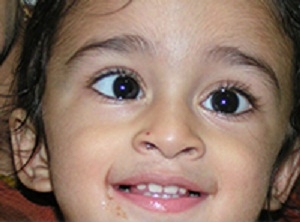+91-9240214610 (Bandra)
+91-9240214611 (Kandivali)




What is a Squint and how to treat it
Childhood eye problems are common. Eyes that ‘wander’, vision problems, eye infections, and eye injuries are all common among children. You can help protect your child’s eyesight by watching out for warning signs and taking your child to a doctor at the first sign of a problem.

Sometimes a child’s eyes do not work together as they should. One eye may be ‘lazy’, or wander in or out, or up or down (strabismus). In such a case, the brain receives a different image from each eye. The brain may switch back and forth between the two images, or it may turn off the weaker image.
Very simply put, squint is an eye condition wherein both the eyes point in different directions. While one eye focuses on a particular object, the other eye focuses away from it—either downwards or upwards. Sometimes it may even focus away and come back, and sometimes it keeps moving back & forth between the object and the surroundings. Such misalignment of the eyes is referred to as squint or strabismus.
Sometimes a child cannot see objects that are far away (near-sightedness) or objects that are close up (far-sightedness). A child can even be so far-sighted that both near and distant objects are blurred.
If the front of the child’s eye (cornea) is irregularly curved (astigmatism), objects look blurry at all distances. However, these common childhood vision problems can almost always be corrected with glasses or contact lenses. In some cases, vision problems can lead to amblyopia if not corrected.
Optical management involves :

If other treatments are unsuccessful, surgery may be needed to correct a squint.
Surgery can be used to:
Surgery involves moving the muscles attached to the outside of the eye to a new position. It may be necessary to operate on both eyes to balance them, even if the squint is only in one eye.
There are six different muscles attached to each eyeball and they tend to work in pairs. During the Strabismus operation it is normal that for a pair of muscles one is weakened and the other strengthened to make the eye straighter. It may be necessary to operate on both eyes to balance them, even if the squint is only in one eye.
In some cases adjustable sutures will be used, so that shortly after the operation any minor adjustments can be made to achieve the best possible position of the eye.
If a muscle is too strong when you have strabismus, it may cause the eye to turn in, turn out or rotate too high or low.
On the other hand, an eye muscle weakness in certain cases may also cause misalignment. This condition may occur if you have a cranial nerve dysfunction affecting how eye muscles control movement.
In a recession procedure, your eye surgeon detaches the affected outside muscle (extraocular muscle) from the eye and reattaches it (resection) farther back on the eye to weaken the relative strength of the muscle if it is too strong.
In contrast, if the muscle is too weak, your surgeon may use a recession procedure to reduce strength of the opposing muscle (antagonist) to achieve more balanced function of the eye muscles.
In certain cases, a resection procedure may be used to strengthen an eye muscle to correct misalignment associated with strabismus. If you have inwardly turned eyes (esotropia), the surgeon may strengthen the lateral rectus muscles — located on the side of each eye, toward the ear — by reattaching the muscle in a different location (resection). In this way, the lateral rectus muscles are relatively strengthened and they can turn the eyes farther outward. This results in better eye alignment.
With adjustable suture eye muscle surgery, your surgeon adjusts sutures holding eye muscles in place after a resection procedure, to attempt to improve your final outcome.
This surgery is probably best for someone in whom strabismus developed in adulthood after previously normal eye alignment.
Adjustable suture surgery is performed in the operating room, with general or local anesthesia. Afterward the eye is patched. About four to 24 hours later, the patch is removed in the office, when anesthesia and sedation have faded. Ocular alignment is then evaluated.
Based on how your eyes are aligned, your surgeon may decide to use the suture that is in place to tighten or loosen the treated muscle. This adjustment may cause slight discomfort, primarily with muscle tightening.
Once the desired alignment is achieved, the surgeon ties the adjustable suture permanently in place, and the procedure is complete.
With the growing age and multiple times facing the problems of blurred vision, the need of doing an eye check up did arouse. I visited Ojas Eye hospital for the tests and soon I was diagnosed with the eye disease called Cataract. My mind was baffled with questions. Friendly approach of Dr.Dedhia, in Pre and post operations, was truly supporting. The advanced eye correction equipment did ensure the rest. My cataract operation is successful and at present I am blessed with clear vision.

DEAR DOCTOR DEDHIA & ALL AT LASER EYE CENTER ;
It is been a wonderful experience to know you all and also to be treated by such a friendly and excellent team of professionals. What you all have done for me is just inexplicable all can say is "Thank you so much" for doing this wonder on my eyes. It really feels great to have an aid less vision. May God bless all of you all health and happiness and wish you all the very best for your work!
Dr. Nitin Dedhia is my family's eye specialist since long time. My grandmoms cataract surgery was done by him around 20 years ago. She is still having very good eyesight at 90. I too have have done my lasic around a week ago and now able to see everything without specs. Would like to advice Dr Dedhia Sir for any of your complaints regarding eyes. The all staff are well trained and cooperative. Good infrastructure too. would thank everyone there.
It was a good experience with Dr. Dedia. He is very particular about cleanliness which I liked. The staff too were quick and courteous.I am also impressed with Dr. Hardik who has explained to me in detail. And Greta too is a very efficient receptionist. Thank you all the staff for not keeping me waiting.